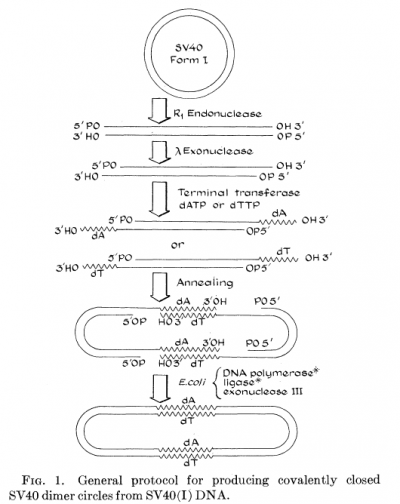Difference between revisions of "Recombinant DNA Technology (Biotechnology and Society)"
From SynBioCyc
(→Additional Background) |
|||
| (8 intermediate revisions by one user not shown) | |||
| Line 1: | Line 1: | ||
== Required Reading == | == Required Reading == | ||
| + | [[File:Jackson1972_Fig_1.png|400px|thumb|right|Figure from one of the first papers reporting the production of a recombinant DNA molecule <cite>Jackson1972</cite>.]] | ||
<biblio> | <biblio> | ||
| − | # | + | #Berg2004 [http://www.nobelprize.org/nobel_prizes/chemistry/laureates/1980/berg-article.html Paul Berg. Asilomar and Recombinant DNA (Nobel Foundation) ] |
| + | // Paul Berg was awarded half the 1980 Nobel Prize for recombinant DNA (the other half went to Gilbert and Sanger for DNA sequencing). This article from 2004 describes the Asilomar conference in a historical perspective and discusses whether that model can be applied to other ethical issues related to biotechnology. | ||
#Fredrickson1991 isbn=0309044863 | #Fredrickson1991 isbn=0309044863 | ||
| − | // Fredrickson, Donald S. "Asilomar and Recombinant DNA: The End of the Beginning" | + | // Fredrickson, Donald S. "Asilomar and Recombinant DNA: The End of the Beginning" pages 258-307 <br> [http://www.nap.edu/openbook.php?record_id=1793&page=258 Read online at National Academies Press.] <br> Pages 259-264 are a brief history of molecular biology that can be skipped. Concentrate on pages 265-284. |
#Jackson1972 pmid=4342968 | #Jackson1972 pmid=4342968 | ||
| − | // Original paper reporting construction of first recombinant DNA molecule. | + | // Original paper reporting construction of first recombinant DNA molecule. You can skim the paper. The main result is shown in Fig. 1. |
</biblio> | </biblio> | ||
| Line 14: | Line 16: | ||
# Who imposed the 6-month moratorium on recombinant DNA research? Why? | # Who imposed the 6-month moratorium on recombinant DNA research? Why? | ||
# What new dangers were possible with the use of recombinant DNA? | # What new dangers were possible with the use of recombinant DNA? | ||
| − | # Was the comparison of recombinant DNA to nuclear weapons appropriate at the time? Why? Why not | + | # Was the comparison of recombinant DNA to nuclear weapons appropriate at the time? Why? Why not? |
# How was the reaction of the public and government different from that of scientists? | # How was the reaction of the public and government different from that of scientists? | ||
| + | # Which potential threats brought up by the scientist at Asilomar turned out to be unfounded? Which are we still concerned about today? | ||
# What organizations or agencies oversee recombinant DNA research today? | # What organizations or agencies oversee recombinant DNA research today? | ||
# What are the lasting effects of the Asilomar model for examining the safety of new biotechnology? | # What are the lasting effects of the Asilomar model for examining the safety of new biotechnology? | ||
| Line 23: | Line 26: | ||
* [http://profiles.nlm.nih.gov/ps/retrieve/Narrative/CD/p-nid/260 The Paul Berg Papers (Profiles in Science, National Library of Medicine)] | * [http://profiles.nlm.nih.gov/ps/retrieve/Narrative/CD/p-nid/260 The Paul Berg Papers (Profiles in Science, National Library of Medicine)] | ||
* [http://www.ndsu.edu/pubweb/~mcclean/plsc431/debate/debate3.htm The Recombinant DNA Debate (Online Course Notes)] | * [http://www.ndsu.edu/pubweb/~mcclean/plsc431/debate/debate3.htm The Recombinant DNA Debate (Online Course Notes)] | ||
| + | * [http://oba.od.nih.gov/oba/rac/Guidelines/NIH_Guidelines.htm NIH Guidelines for Research Involving Recombinant or Synthetic Nucleic Acid Molecules] | ||
| + | <biblio> | ||
| + | #Berg1975 pmid=806076 // Published report resulting from the Asilomar conference. | ||
| + | </biblio> | ||
Latest revision as of 02:24, 4 September 2013
Required Reading

Figure from one of the first papers reporting the production of a recombinant DNA molecule [1].
Error fetching PMID 4342968:
- Error fetching PMID 4342968:
Original paper reporting construction of first recombinant DNA molecule. You can skim the paper. The main result is shown in Fig. 1. - Paul Berg. Asilomar and Recombinant DNA (Nobel Foundation)
Paul Berg was awarded half the 1980 Nobel Prize for recombinant DNA (the other half went to Gilbert and Sanger for DNA sequencing). This article from 2004 describes the Asilomar conference in a historical perspective and discusses whether that model can be applied to other ethical issues related to biotechnology. - ISBN:0309044863
Fredrickson, Donald S. "Asilomar and Recombinant DNA: The End of the Beginning" pages 258-307
Read online at National Academies Press.
Pages 259-264 are a brief history of molecular biology that can be skipped. Concentrate on pages 265-284.
Discussion Questions
- What experiments prompted the Asilomar conference? What new technologies had been developed that made them possible?
- Who imposed the 6-month moratorium on recombinant DNA research? Why?
- What new dangers were possible with the use of recombinant DNA?
- Was the comparison of recombinant DNA to nuclear weapons appropriate at the time? Why? Why not?
- How was the reaction of the public and government different from that of scientists?
- Which potential threats brought up by the scientist at Asilomar turned out to be unfounded? Which are we still concerned about today?
- What organizations or agencies oversee recombinant DNA research today?
- What are the lasting effects of the Asilomar model for examining the safety of new biotechnology?
Additional Background
- The Paul Berg Papers (Profiles in Science, National Library of Medicine)
- The Recombinant DNA Debate (Online Course Notes)
- NIH Guidelines for Research Involving Recombinant or Synthetic Nucleic Acid Molecules
Error fetching PMID 806076:
- Error fetching PMID 806076:
Published report resulting from the Asilomar conference.